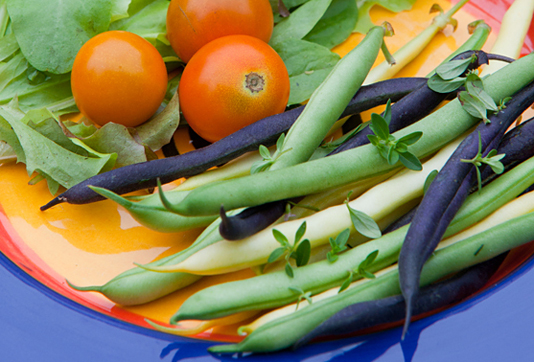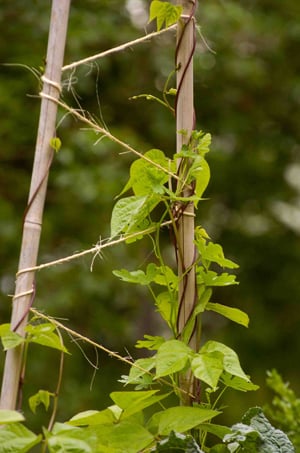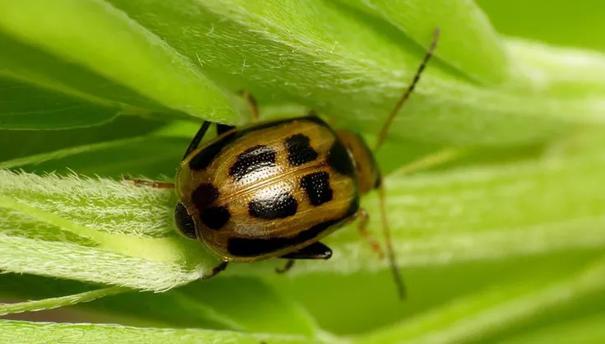Fresh Ideas for Green Beans
When backyard beans are plentiful, use these recipes and techniques to savor the harvest
 Three-Color Beans with Lemon Thyme-and-Mint Dressing features beans in green, purple and yellow.
Three-Color Beans with Lemon Thyme-and-Mint Dressing features beans in green, purple and yellow.Legume is the prosaic name for plants that produce pods.One of the world's most prolific and nutritious food crops in this group is the bean. Both green beans and dried beans can be found in almost every color: red, yellow, green, purple, beige, black and white. While some beans are consumed pod and all, others require the tough pods to be shucked to savor the inner bean.
Despite the diversity, most home gardeners simply grow green beans, also known as snap beans or bush beans. Pole beans are similar, except they grow on a trellis (or a pole), and mature more slowly over a longer period of time. The flavor is similar to green beans. If you grow dried beans, you'll find they are essentially green beans that have been left to grow long enough for the bean to mature inside the pod.
How to Harvest
Harvest green beans before they reach the thickness of a pencil. Any larger and they start to get tough. Regular picking (every couple of days) encourages more beans to form. Avoid picking beans when the leaves are wet because this can spread bacterial blight.
Green beans usually have one big flush, followed by a series of smaller harvests. After a few weeks, the plants stop producing and the leaves turn yellow. At this point, toss them onto the compost pile. To ensure a longer harvest, plant two crops: one in early summer and one late summer. Keep in mind that summer-planted crops typically require longer to mature than spring-planted crops (shorter days and cooler air temperatures slow plant growth). To determine the best planting date, use the days-to-maturity figure on the seed packet but add 14-days as a "low-light factor". When cold weather arrives, protect plants from frost with garden fabric or a cold frame.
 Unlike bush beans, pole beans grow on a pole or trellis and mature more slowly over a longer period of time.
Unlike bush beans, pole beans grow on a pole or trellis and mature more slowly over a longer period of time.Simple Green Beans
In a large pot, bring water to a boil. Add a generous pinch of salt. Add the beans by the handful. Cover and simmer until they are tender yet still have some "snap," about 3 to 4 minutes. Cook another minute. Drain the beans in a colander.
Serving suggestions: Legumes have high amounts of an amino acid called glutamate, which, like sugar, triggers the umami response, a flavor sensation that jangles the pleasure centers of our brains. Before serving, toss the beans with melted butter, freshly ground black pepper and finely chopped thyme or summer savory. Everything else is gilding the lily, because there is nothing more delicious than the flavor of fresh picked beans.
More ideas:
- Toss with a mustardy vinaigrette sauce, a smear of garlicky aioli sauce, or browned butter and slivered almonds.
- For a picnic, serve boiled beans on an antipasto plate with small carrots, hard-boiled eggs, tuna and capers, olives and thinly sliced meats. Leave the stem ends attached to make them easy to eat with your fingers.
Three-Color Beans with Lemon Thyme-and-Mint Dressing
Serves 4
Lemon brings out the flavors of beans, especially when scattered with herbs and a hint of garlic. The purple beans turn green when cooked, but they still have a nice contrast to green beans.
- 1 pound (about 4 cups) mixed green, yellow and purple snap beans
- 2 tablespoons fresh parsley leaves, chopped/li>
- 2 tablespoons fresh mint leaves, chopped
- 2 tablespoons fresh lemon thyme leaves, chopped
- 1 clove garlic, pressed and finely chopped
- 1 teaspoon lemon zest
- 2 tablespoons fresh lemon juice
- 1/4 cup extra virgin olive oil
- 1/2 teaspoon salt
- 1/4 teaspoon freshly ground pepper
In a large pot, bring salted water to a boil. Sort the beans according to size, adding the larger ones to the water first, then the smaller ones so they will cook evenly. Cover, and boil until they are snap-tender, about 5 minutes. Drain, rinse under cold water and drain again. Pat dry.
In a small salad bowl, combine parsley, mint and thyme. Add lemon zest, garlic, olive oil, salt and pepper. Place the cooked beans in a serving dish or bowl, and drizzle with the dressing. Serve at room temperature on a bed of lettuce.
What are shelling beans?
Another type of bean, shelling beans are stripped from the pods before being used. They can be dried and stored to use later or, as a special treat, they can be eaten fresh. When used this way, they cook quickly and don't require soaking as dried beans do.
Confetti Bean Salad
Serves 8
Fresh shelling beans are delicious. Try this with any fresh shelling bean, such as cranberry, cannellini or black turtle. The flavor is best if the beans are allowed to marinate for several hours before serving.
- 1 cup fresh, shucked shelling beans
- 2 red bell peppers, roasted and cut into 1/4-inch strips
- 2 poblano peppers, roasted and finely diced
- 2 large ripe tomatoes, seeded and cut into 1/2-inch pieces
- 3 cups fresh corn kernels
- 1 red onion, thinly sliced
- 1 cup chopped fresh cilantro
- 1/3 cup plus 1 tablespoon olive oil
- 1 clove garlic, peeled and minced
- 2 tablespoons balsamic vinegar
- 2 tablespoons red wine vinegar
- 1 teaspoon cumin seeds, toasted till fragrant in a hot, dry skillet
- Salt and fresh pepper
In a medium saucepan, add the beans and enough cold water to cover by 1 inch. Bring to a boil and reduce heat to low. Simmer until the beans are tender, about 30 to 45 minutes.
Drain and rinse under cold water. Spread on a towel to remove excess moisture. In a large salad bowl, combine beans, peppers, tomatoes, corn, onions and cilantro.
To make the dressing, combine oil, garlic, vinegars, cumin, salt and pepper in a small jar. Shake to emulsify, and pour over the salad. Let stand at room temperature until ready to serve.
Warm Fingerling Potato and Bean Salad
Fingerling potatoes are ideal for potato salad because they have firm, creamy flesh. Red-skinned new potatoes are equally delicious, and add a creamy balance to the bean flavor.
- 6 slices bacon
- 2 pounds fingerling potatoes, scrubbed and peeled
- 1/2 pound (about 2 cups) purple or green snap beans
- 1/3 cup apple cider vinegar
- 1 teaspoon Dijon mustard
- 1 clove garlic, minced
- 1/2 cup extra virgin olive oil
- 1/4 cup finely minced fresh herbs, (summer savory, chives, parsley and basil)
- 1 medium red bell pepper, roasted and cut into 1/4 inch pieces
- 1/4 cup finely chopped fresh basil for garnish
- Salt and freshly ground pepper to taste
In a skillet over medium heat, cook the bacon until crisp and brown, about 8 minutes. Bacon can also be cooked in the oven: Spread on a cookie sheet and bake at 350 degrees F. for 15 minutes. Using a slotted spatula, transfer cooked bacon to paper towels to drain and cool. Crumble the bacon and set aside.
In a medium saucepan, bring lightly salted water to a boil. Add the potatoes and reduce the heat to medium. Cook until the potatoes are tender, about 15 minutes. Using a skimmer or wire sieve, remove the potatoes from the water and rinse under cold water. Set aside to cool slightly. Cut the potatoes into 1/4-inch thick rounds.
Add another teaspoon of salt to the medium saucepan. Add the beans and cook until they are snap-tender, about 5 minutes. Drain in a colander and rinse under cold water. Cut the beans on the diagonal into 1-inch pieces.
In a large salad bowl, whisk vinegar, mustard and garlic; gradually whisk in the oil, adding the herbs at the end. Toss with the potatoes, beans, red pepper and bacon. Sprinkle with the basil and season with the salt and pepper. Serve warm.
Freezing Beans:
If you find you have more beans than you can eat, they are easy to freeze.
First, blanch them as described in Simple Green Beans, above, but cut the cook time in half. Drain and transfer to a large bowl of water, chilled with a tray of ice cubes. This stops the cooking. Drain again, spin in a salad spinner and pat dry. Pack into 1-quart freezer bags, spreading out to form a single layer, suck out the air with a straw and seal. Freeze immediately.
Freezing beans destroys about 25 percent of their antioxidants; canning destroys 50 percent, so it is best to eat fresh beans whenever possible.
Last updated: 06/22/2023
Print this Article:
Related Articles
Get the Dirt
Stay up to date on new articles and advice. Please fill out the information below.




